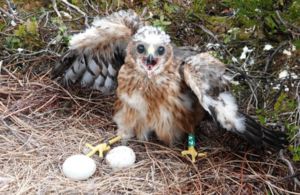141 hen harrier chicks fledge as encouraging population growth recorded
Encouraging population increase as 54 nests recorded

Credit: Natural England
141 hen harrier chicks have fledged in England this year – the seventh year in a row that numbers have increased – according to statistics released today by Natural England (16 September).
Hen harriers are rare and birds of prey that have become an icon for conservation and Nature recovery in England. They are beautiful, striking birds, with a wingspan of over a metre. In Spring they engage in graceful, dramatic ‘sky dancing’ courtship displays, as well a ‘throw and catch’ transfers of food between airborne birds.
The increase in hen harrier chicks successfully fledging means that 2023 is another record year, following 119 chicks recorded from nests in County Durham, Cumbria, Lancashire, Northumberland and Yorkshire in 2022. There are now more hen harriers in England since they were lost as a breeding species around 200 years ago.
Hen harriers were driven to extinction across mainland Britain during the 19th century as the result of illegal persecution and disturbance, only beginning to recolonise during the 1960’s. Just a decade ago there were no hen harriers nesting successfully in England.
Natural England Chair Tony Juniper said:
The continuing year on year increase in the number of hen harriers fledging from English nests is fantastic to see, and shows how through partnership work it is possible to reverse Nature’s decline, even in the most challenging of circumstances. The encouraging numbers we see again this year are testament to the volunteers, landowners and partner organisations who have worked so hard to support and monitor these birds.
Today’s news is, however, overshadowed by continuing illegal persecution, which despite all the good practice among many landowners still stubbornly persists. We know that much more needs to be done to protect these precious birds and remain absolutely committed to working with our partners to stamp out the despicable killing of these wonderful creatures that bring so much joy to so many people. We will continue to work hard, improving monitoring and conservation management to achieve long term recovery.
In 2023, 54 nests were recorded (up from 49 last year), of which 36 were successful (34 last year). This represents an average of 3.9 chicks per successful nest. Northumberland had the highest number of nesting attempts, 17 in total and the highest increase on the year before where 9 nests were recorded. The Yorkshire Dales and Nidderdale area also remained a strong hold with 15 nests recorded in 2023.
The fledglings recorded this year includes 24 brood-managed chicks, taken from six nests on grouse moors and reared to fledging in captivity. The brood management programme is an experiment to see if removing hen harrier chicks from grouse moors for rearing in captivity for later release reduces conflict with game shooting and reduces persecution sufficiently to allow populations to recover. Natural England is committed to a full scientific investigation of this technique and the brood management trial has recently been extended to further understand the impact this has had on their conservation.
Despite this progress, illegal killing of birds of prey remains a serious and ongoing issue which Natural England is working alongside the police and National Wildlife Crime Unit to tackle.
Natural England’s work to protect, monitor and support numbers of hen harriers is part of the Hen Harrier Action Plan. This includes a number of actions to enable hen harriers to thrive, such as a project to reintroduce the birds to southern England, licences for diversionary feeding and improved satellite tracking.
Notes to editors:
- For more information on the hen harrier action plan, visit: Increasing hen harrier populations in England: action plan - GOV.UK (www.gov.uk)